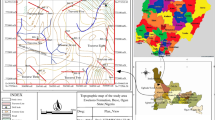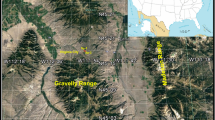Abstract
Geoelectrical methods involving electrical resistivity tomography (ERT), self-potential (SP), frequency domain electromagnetic (FDEM), and very low frequency (VLF) methods have been used to provide valuable information in locating a known sulfide ore body in Soap Gulch, Montana. The study develops basis of comparison for the geophysical techniques employed. Ranges of resistivity along the area have been established using interpreted ERT which can help to understand the subsurface distribution of sulfides in the area. A sulfide body was delineated from the survey area corresponding to anomalously low resistivity values on the ERT section, negative SP, and high apparent current density zone in VLF. Depth to the localized ore zone ranges approximately from 10 to 20 m. FDEM data reflect the conductivity distribution of the shallow subsurface (less than 6 m deep); hence, the delineated sulfide zone had minimal contribution to FDEM measurements. The results of the study show that SP, VLF, and ERT methods provide significant information in localizing ore bodies. The survey revealed that the resistivity values obtained from ERT profile corroborate the FDEM, SP, and VLF from the area.







Similar content being viewed by others
References
Albert NF, Vivian BC, Cheo ES (2012) Application of electrical resistivity and chargeability data on a GIS platform in delineating auriferous structures in a deeply weathered lateritic terrain, Eastern Cameroon. Int J Geosci 3:960–971
Burger HR, Sheehan AF, Jones CH (2006) Introduction to applied geophysics. W. W. Norton and company, New York Norton ISBN-10: 0393926370, 600 P
Charles EC (1985) Spontaneous polarization associated with porphyry sulfide mineralization. Geophysics 50:1020–1034
Edward MS (2000) Electromagnetic methods applied to exploration for deep nickel sulphides in the Leinster area, Western Australia. Explor Geophys 31:222–228
Karous M, Hjelt SE (1977) Determination of apparent current density from VLF measurements. Contribution N. 89. Department of Geophysics, University of Oulu, Finland
Karous M, Hjelt SE (1983) Linear filtering of VLF dip-angle measurements. Geophys Prospect 31:782–794
Loke MH (1995) Least-squares deconvolution of apparent resistivity pseudosections. Geophysics 60(6):1682–1690
McNeill JD (1980) Electromagnetic terrain conductivity measurement at low induction numbers. Technical note TN-6, Geonics limited 18 p
McNeill JD, Labson VF (1991) Geological mapping using VLF radio fields. In: Nabighian MN (ed) Electromagnetic methods in applied geophysics II. Soc Exp Geophys, Tulsa, pp 521–640
Mwenifumbo CJ (1997) Electrical methods for ore body delineation. In: Gubins AG (ed) Proceedings of Exploration 97: Fourth Decennial International Conference on Mineral Exploration. GeoF/X, Toronto, pp 667–676
Ogilvy RD, Lee AC (1991) Interpretation of VLF-EM in phase data using current density pseudo-sections. Geophys Prospect 39:567–580
Parasnis DS (1986) Principles of applied geophysics, 4th edn. Chapman and Hall ltd., London 402 P
Pirttijarvi M (2004) KHFFILTL Karous-Hjelt and Fraser filtering of VLF measurements. Retrieved from https://wiki.oulu.fi/pages/viewpage.action?pageId=20677906. Accessed May 2016
Reynolds JM (2011) An introduction to applied and environmental geophysics. John Wiley and sons ltd, Hoboken 796 p
Sahinen UM (1939) Mining districts of Montana; M.S. Thesis, Montana School of Mines, Butte
Telford WM, Geldart LP, Sheriff RE (1990) Applied geophysics, 2nd edn. Cambridge University press, Cambridge 770 p
Thomas MD, Walker JA, Keating P, Shives R, Kiss F, and Goodfellow WD (2000) Geophysical atlas of massive sulphide signatures, Bathurst mining camp, New Brunswick. Geological Survey of Canada Open File 3887, 105 p
Mining Truth (1930). Montana mining developments. V 15, No.19.p.17
Winchell AN (1914) Mining districts of the Dillon quadrangle, Montana and adjacent areas. US Geological Survey Bulletin, Washington, D.C., p 574
Wolle MS (1963) Montana pay dirt: a guide to the mining camps of the treasure state. Sage Books, Denver
Xia J, Ludvigson G, Miller RD, Mayer L, Haj A (2010) Feasibility of delineating a volcanic ash body using electrical resistivity profiling. J Geophys Eng 7:267–276
Author information
Authors and Affiliations
Corresponding author
Rights and permissions
About this article
Cite this article
Khalil, M., Orubu, A., Rutherford, B. et al. Integrated application of 2D resistivity and electromagnetic methods to investigate a metallic-sulfide deposit in Soap Gulch, Montana. A case study. Arab J Geosci 11, 764 (2018). https://doi.org/10.1007/s12517-018-4130-1
Received:
Accepted:
Published:
DOI: https://doi.org/10.1007/s12517-018-4130-1




